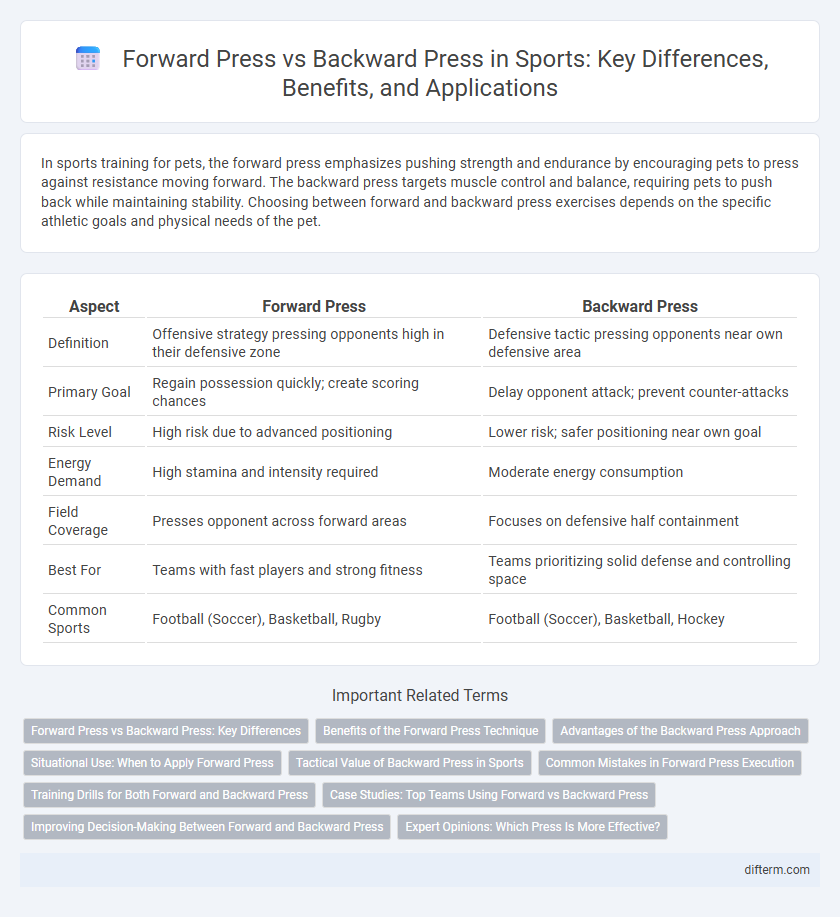In sports training for pets, the forward press emphasizes pushing strength and endurance by encouraging pets to press against resistance moving forward. The backward press targets muscle control and balance, requiring pets to push back while maintaining stability. Choosing between forward and backward press exercises depends on the specific athletic goals and physical needs of the pet.
Table of Comparison
| Aspect | Forward Press | Backward Press |
|---|---|---|
| Definition | Offensive strategy pressing opponents high in their defensive zone | Defensive tactic pressing opponents near own defensive area |
| Primary Goal | Regain possession quickly; create scoring chances | Delay opponent attack; prevent counter-attacks |
| Risk Level | High risk due to advanced positioning | Lower risk; safer positioning near own goal |
| Energy Demand | High stamina and intensity required | Moderate energy consumption |
| Field Coverage | Presses opponent across forward areas | Focuses on defensive half containment |
| Best For | Teams with fast players and strong fitness | Teams prioritizing solid defense and controlling space |
| Common Sports | Football (Soccer), Basketball, Rugby | Football (Soccer), Basketball, Hockey |
Forward Press vs Backward Press: Key Differences
Forward press involves applying pressure towards the opponent's territory, often creating offensive opportunities and controlling the game's pace. Backward press focuses on defensive positioning by retreating and consolidating space to prevent opponent advances, prioritizing strength and resilience. The key difference lies in forward press emphasizing attack and territorial gain, while backward press prioritizes defense and maintaining structure.
Benefits of the Forward Press Technique
The forward press technique in sports enhances balance and stability by engaging core muscles more effectively during movement. It promotes quicker reaction times and improved power transfer, leading to better overall performance in dynamic scenarios. Athletes benefit from increased agility and reduced injury risk due to the proactive foot placement associated with the forward press.
Advantages of the Backward Press Approach
The backward press approach offers superior balance and stability by shifting the center of gravity away from opponents, enhancing control during physical confrontations. This technique allows athletes to conserve energy by utilizing a more efficient body posture, reducing fatigue over extended play periods. Enhanced vision and spatial awareness result from the backward press stance, enabling better anticipation of opponents' movements and strategic plays.
Situational Use: When to Apply Forward Press
Forward press is most effective when a team aims to apply high pressure early in the opponent's build-up phase, targeting defenders and midfielders to force turnovers in dangerous areas. This tactic suits teams with high-energy players capable of sustained pressing, especially during moments when the opposition shows vulnerability in ball circulation or slower transitions. Using forward press in critical moments can disrupt the opponent's rhythm, creating immediate scoring opportunities.
Tactical Value of Backward Press in Sports
The backward press in sports offers significant tactical value by disrupting the opponent's offensive flow and forcing turnovers in critical defensive zones. This strategy allows teams to maintain better positional control and create counter-attacking opportunities through quick transitions. Emphasizing spatial awareness and disciplined positioning, the backward press enhances defensive solidity while maintaining offensive threat potential.
Common Mistakes in Forward Press Execution
Common mistakes in forward press execution often include improper hand placement, leading to wrist strain and reduced stability. Many athletes fail to engage their core sufficiently, causing the hips to sag and diminishing overall power output. Neglecting to maintain a neutral spine further increases the risk of injury and compromises balance during the movement.
Training Drills for Both Forward and Backward Press
Training drills for both forward press and backward press enhance athletes' agility and reaction time by emphasizing precise footwork and directional control. Forward press drills often incorporate sprint starts and explosive forward movements to develop power and speed, while backward press exercises focus on controlled retreat steps and backward shuffling for defensive positioning. Incorporating resistance bands and ladder drills improves muscle strength and coordination essential for effective execution of both pressing techniques in sports like basketball and soccer.
Case Studies: Top Teams Using Forward vs Backward Press
Top football clubs like Liverpool and Bayern Munich effectively employ the forward press to disrupt opponents early, capitalizing on quick ball recovery and high-intensity pressure. Conversely, teams such as Juventus and Atletico Madrid utilize the backward press strategy to maintain defensive solidity and control the game's tempo, relying on organized shape and patient build-up play. Case studies reveal that forward press maximizes aggressive transitions, while backward press enhances defensive resilience, influencing overall team performance and tactical outcomes.
Improving Decision-Making Between Forward and Backward Press
Improving decision-making between forward and backward press in sports involves analyzing situational factors such as opponent positioning, team formation, and ball control to optimize defensive strategies. Forward press accelerates ball recovery and disrupts opponent play but demands high stamina and tactical awareness to avoid exposure to counterattacks. Backward press offers defensive stability and controlled transitions but requires precise communication and spatial organization to maintain pressure without conceding space.
Expert Opinions: Which Press Is More Effective?
Expert opinions on forward press versus backward press in sports training emphasize muscle activation and joint safety. Forward press techniques typically engage the pectorals, deltoids, and triceps more effectively, promoting greater upper body strength development. Conversely, backward press can reduce shoulder strain but may limit overall power output, making forward press the preferred choice among strength conditioning specialists for maximizing performance gains.
forward press vs backward press Infographic

 difterm.com
difterm.com